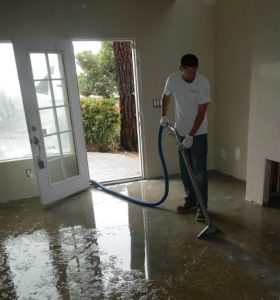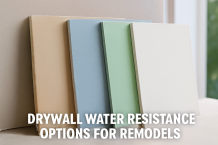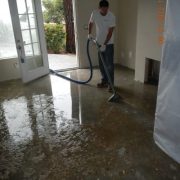
Flood Damage Cleanup – Hire a Pro
Floodwater destroys property in a way nothing else can. It is one of the most destructive and yet common types of natural disasters that strike homes in America. While some homeowners are able to secure their property from flood damage cleanup and water damage, more often, flood disasters are simply unavoidable.
When the water finally recedes, the first thing homeowners want to do is get back into their homes and start over. But to get your personal space habitable and safe you need to do a whole lot more than just drying everything out. Rebuilding too quickly after a flooding incident can cause bigger problems (wood deterioration, insect infestation, mold growth) down the line.
To salvage as much as you can, calling in a flood damage cleanup contractor or a local restoration company is the best way to go. Companies such as ours, have access to the most sophisticated cleaning equipment designed for water disasters. So instead of DIY-ing the cleanup, it would be wise to hire a restoration professional as this would drastically cut down expenses in the long run.
What to Do Before Your Flood Damage Cleanup Contractor Arrives
While waiting for the flood damage cleanup contractor, here’s what you can do to deal with water damage until help arrives:
- Before entering the area, evaluate safety. Inspect for electrical and structural damage from the outside.
- Check for gas leaks, fire hazards and electrical wires.
- Wear protective gear (rubber gloves, eye protection, sturdy footwear, and a face mask) to protect yourself from injury and mold inhalation.
- Be on the lookout for snakes, animals, and fire ants
- Focus on preventing mold growth. Dry your home as much as possible. As soon as the water recedes and enters your home is safe, open windows and doors and set up fans (box fans, oscillating fans) to blow air outside. . You don’t need to purchase fancy equipment. Leave the fancy equipment to the professionals. Just get the air flowing. Blow air against walls as mold thrives in wet and dark areas.
- Toss items you can no longer save. Throw away carpet and padding that has been submerged. Other items that cannot be repaired or disinfected include upholstered furniture, mattresses, rugs, stuffed toys, baby toys, pillows, cosmetics, books, wallpaper, insulation, dry wall, and most paper products.
- If your vents have been exposed to floodwater, don’t turn your HVAC back on until the ducts have been professionally inspected and cleaned.
How to Prevent a Flood
Floods are a major threat to homes and other buildings. If you live in an area that is prone to floods, you need to be prepared. Here are some tips on how to prevent floods in your home.
First, you should make sure that your home has a good foundation. This is because the weight of your home will be supported by the foundation. If the foundation is weak or faulty, then your home could easily sink into the ground when it is flooded. In addition, you should ensure that there are no cracks in your foundation. Cracks can allow water to seep into your home and cause more damage.
You should also check for any cracks in your walls and roof. These are two areas that can easily let water in. You should repair these cracks as soon as possible so that they do not get worse.
You should also consider installing a sump pump. A sump pump is a device that will automatically pump water out of your basement if the level of water rises. This will prevent your basement from flooding. It is important to note that a sump pump should be installed at least 3 feet above the floor.
In addition, you should check your pipes. This is especially important if you have a pipe that runs through your basement. Make sure that this pipe is properly sealed and that there are no leaks.
Finally, you should check your attic. An attic is a great place for water to accumulate. If you have a lot of attic space, then you should install a dehumidifier to remove the excess moisture. You should also check for any cracks or holes in the attic ceiling. If you find any of these problems, then you should fix them immediately.
Preventing floods in your home is very important. By taking these steps, you can save your home from extensive damage.
Serving San Diego and San Diego County for over 30 years with quality work and great service. We also service these cities – Chula Vista, El Cajon, La Mesa, Spring Valley, and Lakeside, California. Poway, Ramona, Alpine, Julian, Santee, Coronado, Imperial Beach, Pacific Beach, La Jolla, University City, Tierrasanta, Rancho Penasquitos, Rancho Bernardo, Rancho Santa Fe, Encinitas, Del Mar, Solana Beach, Leucadia, Sorrento Valley, Miramar, Mira Mesa, Scripps Ranch, Vista, Carlsbad, Oceanside, San Marcos, Lemon Grove, Bonita, Valley Center, Borrego Springs, Escondido, Fairbanks Ranch, Rancho San Diego 4S Ranch, Sabre Springs and Pine Valley.















Follow Us!